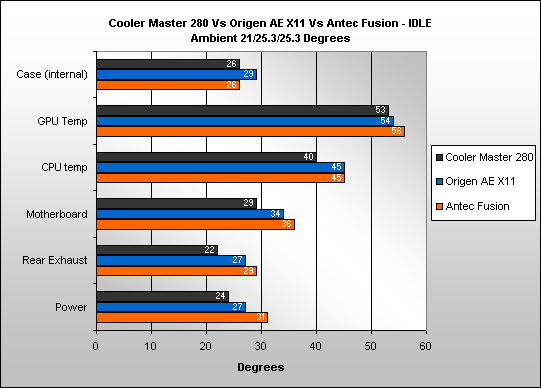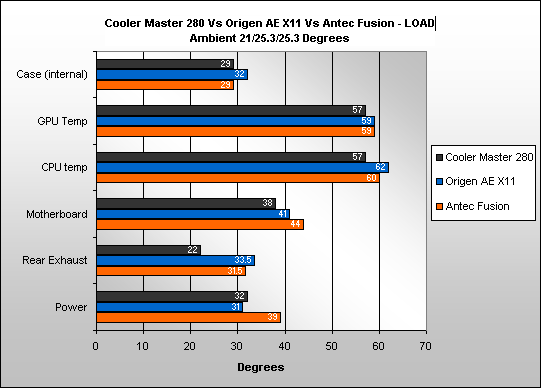Thermal Performance
The usual thermal tests were done on the Cooler Master 280, with our desktop kit happily sliding into place for a bit of burn-in testing.| HEXUS Chassis test equipment specification | |
|---|---|
| Motherboard | Intel 955XBK |
| Processor | Intel Pentium Extreme Edition 840 (3.2GHz, Smithfield core) |
| Memory | 2GiB (2 x 1GiB) OCZ DDR2 PC4200 Value Pro Dual-Channel |
| Graphic Card | ASUSTek GeForce 6800 256MiB Ultra PCIe |
| Power Supply | Antec Neo HE 430W |
| Hard Drive | Seagate Barracuda 160GB SATA |
| Optical Drive | Pioneer 110 DVD Re-Writer |
With a couple of loops of SiSoft Sandra Pro either side of a 3DMark06 loop we managed to get through the test without any errors, which is nice.

Of course, first inspection of the above chart would make you think the '280 outperformed our past HTPC review samples with ease, but we have to point out the 4-degree ambient difference between the 280 and its company in thesel tests may be the main reason for the thermal performance differentiation.
Considering ambient temperatures, the '280 begins to look a little poor in comparison, with only the CPU and motherboard reporting significantly lower temperatures at idle. You’ll need to pay attention to the GPU reading at idle, as the motherboard has been flipped around and the GPU is now facing upwards, looking straight into the beady eyes of the power supply with little in the way of airflow.

The odd thing under load was the CPU temperature, catching up with the Antec Fusion, which was tested in an environment a whole 4 degrees higher. Likewise, the GPU continued to remain a bit on the toasty side considering the ambient, and the power did exactly as we expected, loosing out to the origin AE. It's all about airflow here, and in either orientation the '280 just doesn’t cope as well as the competition.









